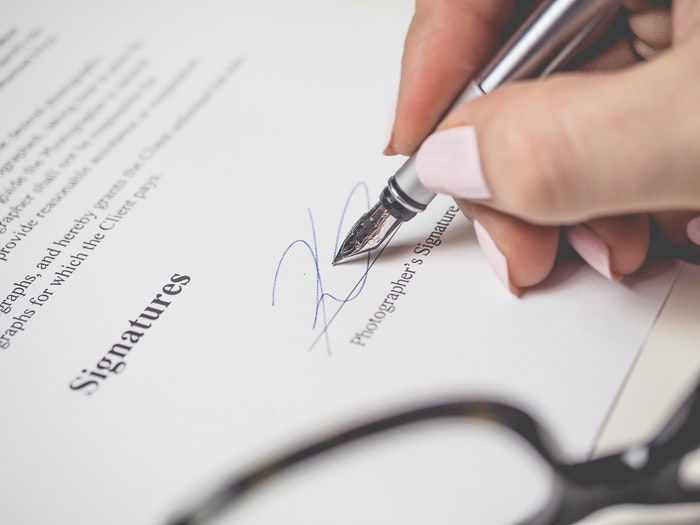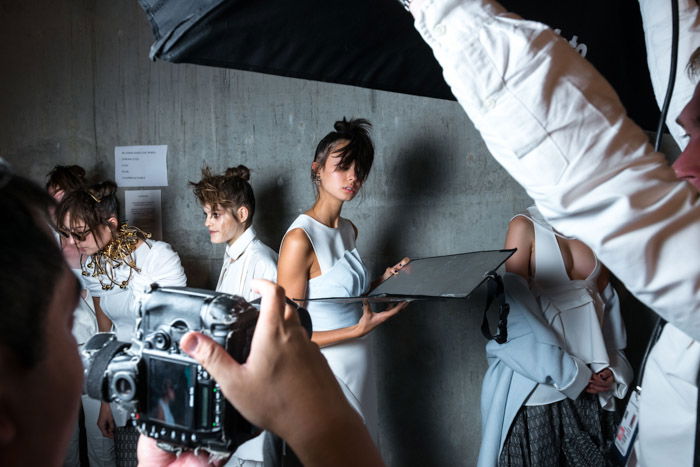A model release form can range from a single page of simple text to a hefty document that includes complicated legal terms. As a photographer, it’s important to know when you need the form and what you should include in it. [This article does not contain any legal advice and is intended for educational purposes only.]
What is a Model Release Form and Why is it Important?
A simple model release form is a contract. It is one of the most important legal documents you need as a photographer. The relevant laws for different states and countries will differ, so you have to be extra thorough when creating one for your needs. The form includes the rights of the image owner, the customer, and the model to prevent any lawsuit or settle any future complications. You will need it if you photograph professional models or candid photo shoots. Creating model release forms is a crucial step in commercial photography. It allows (or restricts) the use of images for the purposes of promotion or sales. Normally, there is no legal requirement to have a signed agreement between a publisher, photographer, or model. But, it’s a good idea to have this agreement in place to cover your legal rights.
Is it Enough to Have a Standard Model Release Form for Every Situation?
Absolutely not! The trickiest part of writing a model release form is that every single country and state has different laws and regulations. It means that you have to conduct thorough research depending on where you take and use the photos. The need for a model release form also depends on the intended use of your images. If you use it for commercial purposes, you’ll often need to have a model release form. However, it depends on the contract you have with the model agency. Also, consider that publishing an image doesn’t always mean that it is used for commercial purposes. If your photos appear in newspapers or educational books, you don’t always need a model release form. But again, country and state laws differ, and it is better to do your homework to be on the safe side.
Many photographers think that they don’t need a model release form if the subject’s face cannot be identified. This might be true but think about other characteristic traits like tattoos, uniforms or hairstyles. If you fail to write a model release form and the subject can be identified, you might have to deal with the legal consequences. Another aspect to consider is the location where you took the photograph. Often, you don’t need to have a model release form if you capture your subjects in public places. However, if there is a chance you will use the image for commercial purposes, you need a model release form even for street photography. Our best advice? Get familiar with the local laws about personal rights and image-making. If you want to be 100% sure, seek legal advice. It might cost you more money, but it is better to be safe than sorry.
What Should Your Model Release Form Say?
A simple model release form is a contract that allows the commercial use of images. There is a basic idea of what needs to be in this contract. Again, the details can differ between states and countries. There are so many photography model release forms and resources out there. We recommend working from a template and avoiding creating your own model release form template from scratch. The idea with the contract is that it protects the interests and the rights of both parties. It is a two-way street. It helps both parties and safeguards them against unwanted actions. You are, after all, asking for the legal rights of images. Those captured in the image relinquish their right or claim over how, where, and when these images appear. In an ideal case, a photography model release form should be short and sweet. It needs to contain the photographed persons’ name, address, phone number, and a witness. However, there are much longer versions used for more important, commissioned work. The shorter versions are more for unplanned photographs.
Our Free Templates
Event Photography – Use this contract template for other events apart from weddings. For example, the release of a new product, photographing an art fayre or party. Portrait Photography – This template is perfect for photographing portraits other than the wedding day shoot. It might be an engagement party or studio shoot, focusing only on the person. Corporate headshots are a perfect example. Wedding Photography – This wedding photography template is specifically for that magical day. There are many things that need to be accounted for, hence this specific contract. Photography Session – Use this template for any photography session, for studio or outdoor use. It might be for family sessions, photographing pets or newborn babies. Model Release Simple – This model release is simple, mainly for when you photograph many people over a short space of time. This is perfect for street photography. Model Release Full – A full model release would be needed for fashion or lifestyle photography, where the images would be used nationally or internationally. Model Release Minors – This model release is specifically for those under 18 years of age. A guardian or parent needs to be present because the contract can be finished.
NB: All of these templates are on our Google drive and are free to view and download.
Conclusion
Always check the local regulations and laws before taking photographs of anyone. Have model release forms at hand in case you need one. You will have to present the model release form when you want to use or sell the image and for other future issues that may arise. Also, it will stop legal proceedings or allow you to defend yourself if ever sued. Some people may be hesitant in signing these forms. Often, the contract doesn’t state where and when you will use it. It only says that you can use it anywhere, at any time, for anything. You will need to respect their decision if they refuse to sign the form. To make things even easier, we have a post on best model release apps to check out next!








title: “Free Model Release Form For Photography How To Write One " ShowToc: true date: “2022-12-30” author: “Brett Love”
A model release form can range from a single page of simple text to a hefty document that includes complicated legal terms. As a photographer, it’s important to know when you need the form and what you should include in it. [This article does not contain any legal advice and is intended for educational purposes only.]
What is a Model Release Form and Why is it Important?
A simple model release form is a contract. It is one of the most important legal documents you need as a photographer. The relevant laws for different states and countries will differ, so you have to be extra thorough when creating one for your needs. The form includes the rights of the image owner, the customer, and the model to prevent any lawsuit or settle any future complications. You will need it if you photograph professional models or candid photo shoots. Creating model release forms is a crucial step in commercial photography. It allows (or restricts) the use of images for the purposes of promotion or sales. Normally, there is no legal requirement to have a signed agreement between a publisher, photographer, or model. But, it’s a good idea to have this agreement in place to cover your legal rights.
Is it Enough to Have a Standard Model Release Form for Every Situation?
Absolutely not! The trickiest part of writing a model release form is that every single country and state has different laws and regulations. It means that you have to conduct thorough research depending on where you take and use the photos. The need for a model release form also depends on the intended use of your images. If you use it for commercial purposes, you’ll often need to have a model release form. However, it depends on the contract you have with the model agency. Also, consider that publishing an image doesn’t always mean that it is used for commercial purposes. If your photos appear in newspapers or educational books, you don’t always need a model release form. But again, country and state laws differ, and it is better to do your homework to be on the safe side.
Many photographers think that they don’t need a model release form if the subject’s face cannot be identified. This might be true but think about other characteristic traits like tattoos, uniforms or hairstyles. If you fail to write a model release form and the subject can be identified, you might have to deal with the legal consequences. Another aspect to consider is the location where you took the photograph. Often, you don’t need to have a model release form if you capture your subjects in public places. However, if there is a chance you will use the image for commercial purposes, you need a model release form even for street photography. Our best advice? Get familiar with the local laws about personal rights and image-making. If you want to be 100% sure, seek legal advice. It might cost you more money, but it is better to be safe than sorry.
What Should Your Model Release Form Say?
A simple model release form is a contract that allows the commercial use of images. There is a basic idea of what needs to be in this contract. Again, the details can differ between states and countries. There are so many photography model release forms and resources out there. We recommend working from a template and avoiding creating your own model release form template from scratch. The idea with the contract is that it protects the interests and the rights of both parties. It is a two-way street. It helps both parties and safeguards them against unwanted actions. You are, after all, asking for the legal rights of images. Those captured in the image relinquish their right or claim over how, where, and when these images appear. In an ideal case, a photography model release form should be short and sweet. It needs to contain the photographed persons’ name, address, phone number, and a witness. However, there are much longer versions used for more important, commissioned work. The shorter versions are more for unplanned photographs.
Our Free Templates
Event Photography – Use this contract template for other events apart from weddings. For example, the release of a new product, photographing an art fayre or party. Portrait Photography – This template is perfect for photographing portraits other than the wedding day shoot. It might be an engagement party or studio shoot, focusing only on the person. Corporate headshots are a perfect example. Wedding Photography – This wedding photography template is specifically for that magical day. There are many things that need to be accounted for, hence this specific contract. Photography Session – Use this template for any photography session, for studio or outdoor use. It might be for family sessions, photographing pets or newborn babies. Model Release Simple – This model release is simple, mainly for when you photograph many people over a short space of time. This is perfect for street photography. Model Release Full – A full model release would be needed for fashion or lifestyle photography, where the images would be used nationally or internationally. Model Release Minors – This model release is specifically for those under 18 years of age. A guardian or parent needs to be present because the contract can be finished.
NB: All of these templates are on our Google drive and are free to view and download.
Conclusion
Always check the local regulations and laws before taking photographs of anyone. Have model release forms at hand in case you need one. You will have to present the model release form when you want to use or sell the image and for other future issues that may arise. Also, it will stop legal proceedings or allow you to defend yourself if ever sued. Some people may be hesitant in signing these forms. Often, the contract doesn’t state where and when you will use it. It only says that you can use it anywhere, at any time, for anything. You will need to respect their decision if they refuse to sign the form. To make things even easier, we have a post on best model release apps to check out next!







